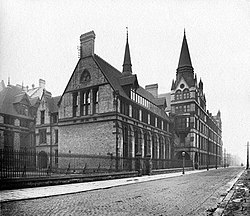| The University of Manchester Library | |
|---|---|
 Main library looking towards the entrance from Burlington Street | |
 | |
| Location | Oxford Road, Manchester, England |
| Type | Academic library |
| Established | 1851 |
| Branches | 10 |
| Collection | |
| Items collected | Books, journals, newspapers, magazines, sound and music recordings, maps, prints, drawings and manuscripts |
| Size | Over 4 million items [1] [2] |
| Access and use | |
| Population served | Greater Manchester and worldwide |
| Members | The University of Manchester (and some other groups on application) |
| Other information | |
| Director | Christopher Pressler |
| Employees | 300+ |
| Website | library.manchester.ac.uk |
The University of Manchester Library is the library system and information service of the University of Manchester. The main library is on the Oxford Road campus of the university, with its entrance on Burlington Street. There are also ten other library sites, eight spread out across the university's campus, plus The John Rylands Library on Deansgate and the Ahmed Iqbal Ullah Race Relations Resource Centre situated inside Manchester Central Library.
Contents
- Contents
- Library buildings
- History
- 1824–1851
- 1851–1936
- 1936–present
- Former librarians
- References
- Further reading
- External links
In 1851 the library of Owens College was established at Cobden House on Quay Street, Manchester. This later became the Manchester University Library (of the Victoria University of Manchester) in 1904. In July 1972 this library merged with the John Rylands Library to become the John Rylands University Library of Manchester (JRULM). [3] [4]
On 1 October 2004 the library of the Victoria University of Manchester merged with the Joule Library of UMIST forming the John Rylands University Library (JRUL). [5] The Joule Library was the successor of the library of the Manchester Mechanics' Institute (established in 1824) which later became the library of the University of Manchester Institute of Science & Technology (UMIST). One of the institute's first actions was to establish a library, with a full-time librarian, at premises in King Street, Manchester. The library changed its name in the summer of 2012 to become The University of Manchester Library.
The library is one of only five National Research Libraries – an award of the Higher Education Funding Council for England (HEFCE), and the only one in the north of England. [6] It is a member of the North West Academic Libraries consortium (NoWAL) [7] and of Research Libraries UK consortium (RLUK). RLUK was formerly the Consortium of University Research Libraries (CURL) of which the library was a founder member in the 1980s.
The present university librarian and director, Christopher Pressler, is assisted by an executive team of one archivist and three librarians. [8]






